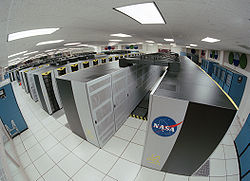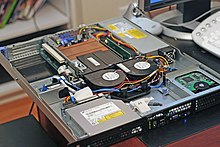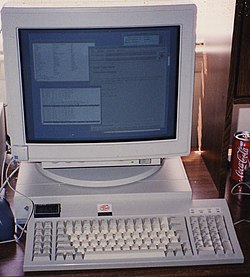Introduction to Computers/Computer types
Course Navigation
| << Previous - History | Next - Hardware and software >> |
|---|
|
Introduction to Computers → Computer types
|
| Completion status: this resource is considered to be ready for use. |
Supercomputer
[edit | edit source]
Supercomputers are the fastest and the most expensive computers. Their huge processing power mean they can be used for complex applications such as predicting protein folding patterns (something really really complex). They're normally used to solve very complex science and engineering problems. Supercomputers get their processing power by taking advantage of parallel processing; they use lots of CPUs at the same time on one problem. A typical supercomputer can do up to ten trillion individual calculations every second.
Example Supercomputers:
Further reading on supercomputers.
Mainframe
[edit | edit source]
They come second to super computers. They have the following features:
- they are larger in size compared to other computers
- Have larger capacity and are more powerful in terms of processing speed
Server
[edit | edit source]
Similar to mainframes in that they serve many uses with the main difference that the users (called clients) do their own processing usually. The server processes are devoted to sharing files and managing log on rights.
A server is a central computer that contains collections of data and programs. Also called a network server, this system allows all connected users to share and store electronic data and applications. Two important types of servers are file servers and application servers.
Workstation
[edit | edit source]
Workstations are high-end, expensive computers that are made for more complex procedures and are intended for one user at a time. Some of the complex procedures consist of science, math and engineering calculations and are useful for computer design and manufacturing. Workstations are sometimes improperly named for marketing reasons. Real workstations are not usually sold in retail.
The movie Toy Story was made on a set of Sun (Sparc) workstations [1]
Perhaps the first computer that might qualify as a "workstation" was the IBM 1620.
| Search for Workstation on Wikipedia. |
The Personal Computer or PC
[edit | edit source]
PC is an abbreviation for a Personal Computer, it is also known as a Microcomputer. Its physical characteristics and low cost are appealing and useful for its users. The capabilities of a personal computer have changed greatly since the introduction of electronic computers. By the early 1970s, people in academic or research institutions had the opportunity for single-person use of a computer system in interactive mode for extended durations, although these systems would still have been too expensive to be owned by a single individual. The introduction of the microprocessor, a single chip with all the circuitry that formerly occupied large cabinets, led to the proliferation of personal computers after about 1975. Early personal computers generally called microcomputers, sold often in kit form and in limited volumes and were of interest mostly to hobbyists and technicians. By the late 1970s, mass-market pre-assembled computers allowed a wider range of people to use computers, focusing more on software applications and less on development of the processor hardware. Throughout the 1970s and 1980s, home computers were developed for household use, offering some personal productivity, programming and games, while somewhat larger and more expensive systems (although still low-cost compared with minicomputers and mainframes) were aimed for office and small business use.

Today a personal computer is an all rounded device that can be used as a productivity tool, a media server and a gaming machine. The modular construction of the personal computer allows components to be easily swapped out when broken or upgraded.
| Search for Personal Computer on Wikipedia. |
Microcontroller
[edit | edit source]
Microcontrollers are mini computers that enable the user to store data, do simple commands and tasks, with little or no user interaction with the processor. These single circuit devices have minimal memory and program length but can be integrated with other processors for more complex functionality. Many such systems are known as Embedded Systems. Examples of embedded systems include Smartphones or car safety systems.
Microcontrollers are important, they are used everyday in devices such as appliances and automobiles.
| Search for Microcontroller on Wikipedia. |
Course Navigation
| << Previous - History | Next - Hardware and software >> |
|---|


